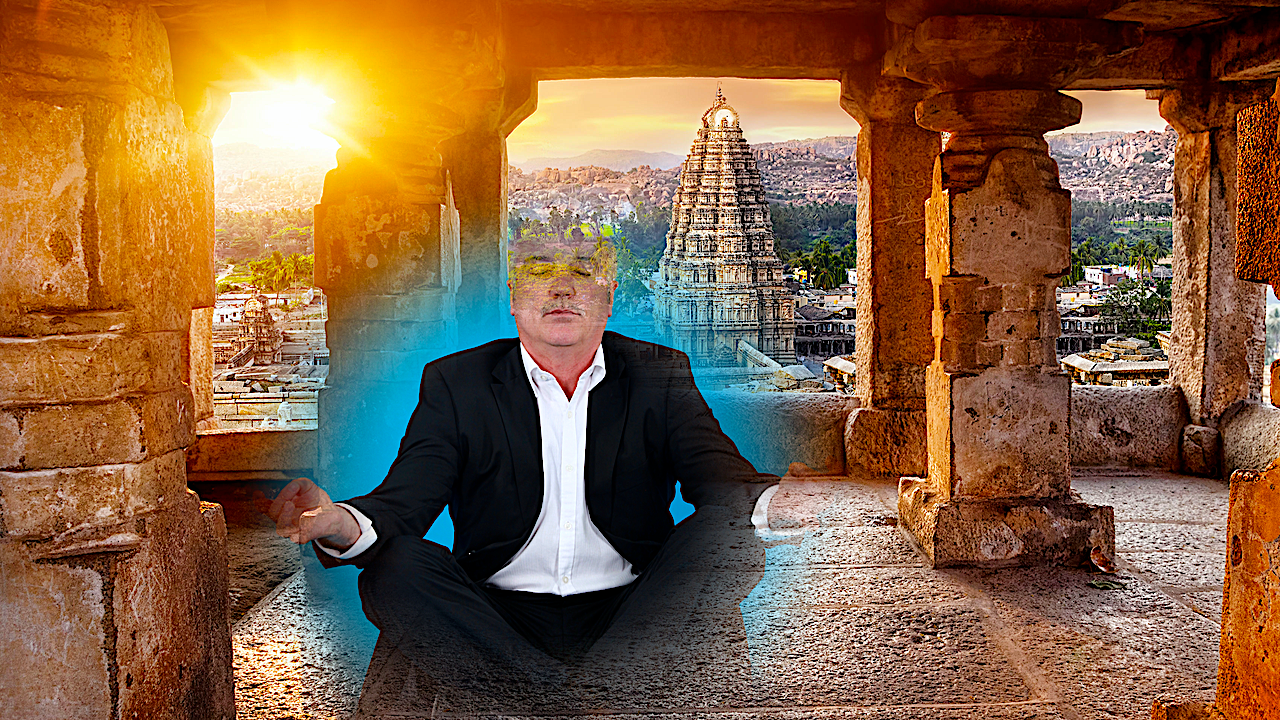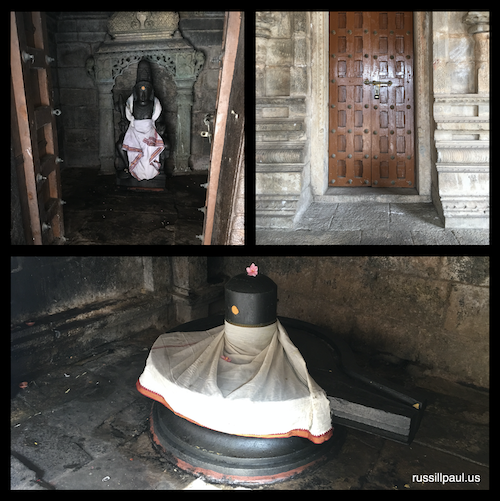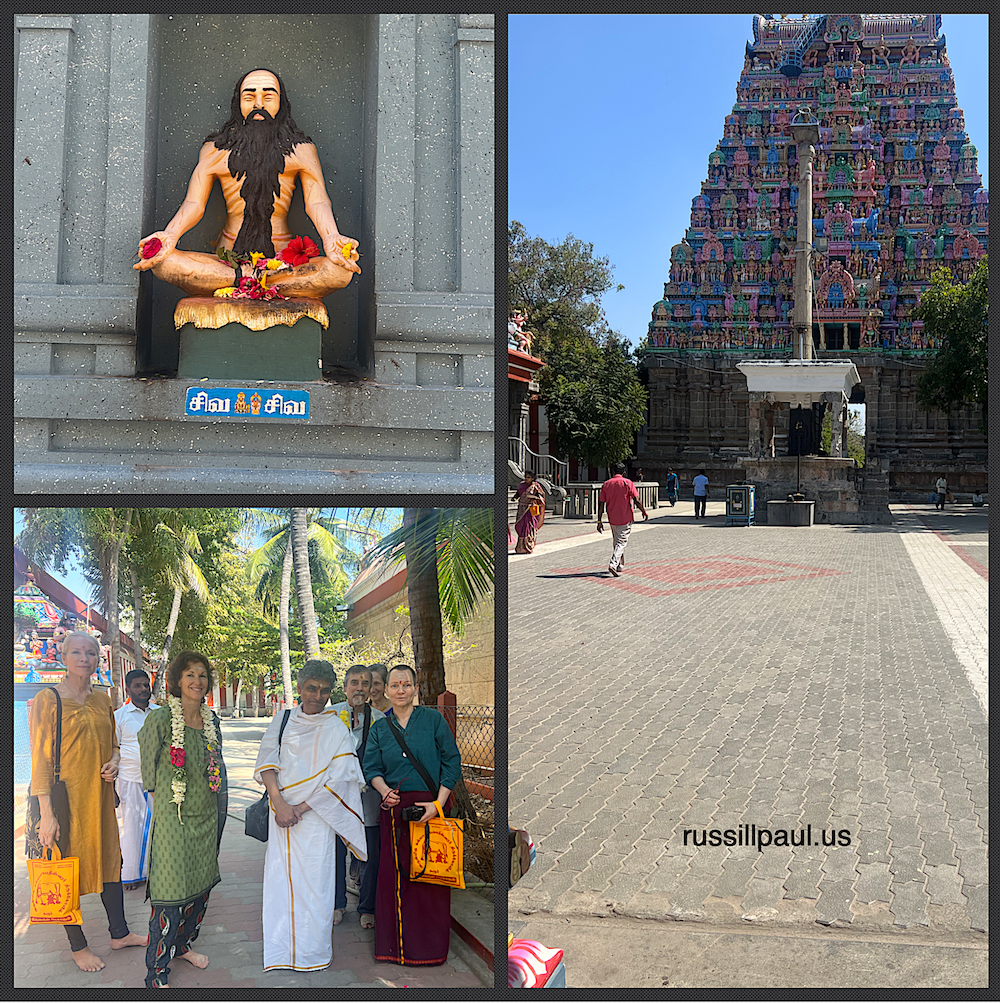Meditating In The Temple

I first encountered a Hindu meditating in the temple in Chennai, my native city. My staunch Roman Catholic father did not force me to attend church or to take Catechism classes, but he became concerned about my Hinduness in later years. When I was five, we moved to an orthodox Hindu neighborhood, and my parents enrolled me in the Hindu school nearby. These were among the best years of my life because the influence of Hinduism affected every part of my life. However, my connection to Hinduism is much deeper than the circumstances of my childhood.
In traditional Hindu temples, seeing men and women sitting in deep meditation is expected. You may see them sitting outside one of the shrines within the temple complex. Sometimes, they are positioned alongside the outer wall after you enter the central courtyard. Some you will find within the exterior of the inner sanctum. No matter where they are seated, the depth of their absorption is striking.
Now these are not gurus or yogis or mendicant monks. They are regular folks, householders who come to the temple for devotional worship and become absorbed in the holy mystery. The men are often dressed in shirts and trousers, indicating they are office-going. The women are always in saris, but it is evident they are family women from the red smear of vermillion in the parting of their hair.

Recently, Asha shared her experience of Tamils being the "salt of the earth," meaning they are honest, hard-working people. I could not agree more. Each time we visit our native state, we are struck by the warmth and beauty of the Tamil people.
Many of us in the West, including Asha and I, are committed to our meditation practice. However, something about the atmosphere of a traditional Hindu temple pulls us deep into the substratum of consciousness, which is not something we come across willy-nilly in our regular meditation practice. This mysterious something draws us on a pilgrimage to India yearly, something we've been doing since 1999.
Strangely, our first pilgrimage to India was conducted not because we wanted to make a pilgrimage but because we kept getting requests from people who attended our workshops around the US to take them on a pilgrimage and retreat in India. We were constantly giving retreats and workshops around the country with our good friend Wayne Teasdale, author of "The Mystic Heart," who passed in 2004. It was such a challenging experience organizing it that we never wanted to do it again, except that we could only take half the group who had signed up, which was already about 25 people. We had another 12 registered, who we promised to take the following year.
Fortunately, the process became more manageable as we learned how to care for our pilgrims in India, and we started to enjoy it immensely. With the publishing of my CDs and books, there was a tremendous interest among people who wanted to chant with us in India and study the Yoga of Sound in the pristine environment of the ashram in which I had received my monastic training. Every year, we would close registration in the fall and start a waiting list that would transfer to the following year.
The hallmark of our experience is the South Indian temples, especially in Tamilnadu, built in the Dravida architectural style, which is not merely a cultural masterpiece of art but a spiritual configuration of energy. Something buried in the ground facilitates this downward pull into our depths. I had received my early studies in Sanskrit and music near the temples, but, at that time, I did not know the power that lay in their ground. I would spend many afternoons on the temple grounds meditating in various shrines between my Sanskrit morning and music classes in the evening.

Dravida architecture first developed in the 8th century, Common Era, in the port city of Mamallapuram during the Pallava dynasty. From here, it spread over other parts of South India and overseas as far as Angor Watt. The Dravida architecture evolved quite rapidly. Within a few hundred years, the Chola dynasty had perfected it to include critical components. By the 10th century, we have the fantastic, 1000-year-old structures we travel today on our pilgrimages. In Tanjore, the Big Temple, Brihadishwara, is a classic example of Dravida architecture.
So what pulls us deep into our depths when we meditate in a Hindu temple, specifically this structure developed in the Dravida-style architecture? The secret to this mystical experience is the secret yantra, or mandala, buried in the ground! The external temple is a holographic projection of this yantra. Even though the temple itself is animated by mantras and pujas, mystical chants, and healing rituals, the hidden yantra is its true power source.
Traditional Shiva temples, especially those in our native state of Tamilnadu, use this system, which is one of the reasons we make the trip to India, to experience this vibrational pull when meditating in those temples. The only other place in the world where I had a similar experience to the ground of our Tamil temples is in the Vorarlberg region of the Austrian Alps. Asha and I performed music at the Propstei Sankt Gerold, like Carnegie Hall in Europe. One day, a small group of us trekked to the source of a mountain stream. On the way down, I sat on a rock and experienced a spontaneous state of samadhi. The gravitational pull was immense!
After covid, we feel the responsibility of taking people to India on pilgrimage is too much for us. And so we've decided that January 2024 will be the last time we take a group to meditate in these thousand-year-old temples.
As Christopher Fry states eloquently in his Sleep of Prisoners: "
"Thank God our time is now
when wrong comes up to face us everywhere,
never to leave us till we take the longest stride of soul we ever took.
Affairs are now soul size.
The enterprise is exploration into God.
Where are you making for?"
CLICK HERE TO JOIN US IN JANUARY 2024
The last time we offer our signature pilgrimage



